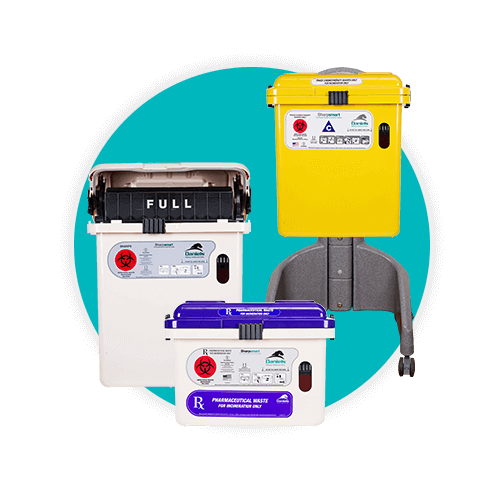Guide to Colorado Medical Waste Regulations

Colorado is known for being one of the best state's in the country for outdoor adventures. To preserve the pristine condition of the Colorado envionment, the state has very stringent medical waste regulations. Guidelines for healthcare waste disposal in the state of Colorado fall under the purview of the Department of Public Health and Environment.
Anyone working in in a healthcare or medical capacity in the Centennial State should be well aware of regulations and policies for biomedical waste disposal, sharps container usage, and overall healthcare waste segregation and management.
Finding those rules isn’t always so easy but we are here to help.
Guidelines and resources for healthcare waste management in Colorado
The Colorado Department of Public Health and Environment provides numerous resources and information regarding medical, pharmaceutical, and biohazard waste disposal. A number of resources are available including training videos and dozens of resources, including but not limited to Resource Conservation and Recovery Act (RCRA) regulations of the Environmental Protection Agency applicable to assisted-living facilities to major hospital medical waste generators, transporters, and state-approved treatments.
Daniels Health understands that it can be daunting to go through state regulations for specifics, and Colorado’s state guidelines are no different. Colorado’s regulations pertaining to solid waste sites and facilities are found in Part one, Section 13 of Colorado’s Code of Regulations (6 CCR 1007-2).
Part One: Regulations pertaining to Solid Waste Sites and Facilities (update effective January 2019) also contains the Statements of Basis and Purpose and Specific Statutory Authority for 6 CCR 1007-2 (Solid Waste Regulations).
If you take the time to look at this document, you’ll find that it’s over 250 pages long! Who has the time to read through that, let alone understand all the legalese, not to mention that this single document basically just defines purposes of the guidelines, determinations of terminology, and scope and applicability and updated sections? Confusing yes, and you’ve only just gotten started!
Taking a look at Colorado’s Code of Regulations can be just as daunting. You have to scroll down the list of regulations to find topics pertinent to your questions. For example, it’s not until you get down to 6 CCR 1007-3 that you come to the topic of hazardous waste disposal.
Clicking on the PDF link to this rule, you’re likely thinking that you’re going to get specific information on the state’s guidelines for the handling, packaging, labeling, and disposal of hazardous waste, aren’t you – but you may be surprised. What you end up with is two pages filled with code sections numbers (hundreds of them), and dates of prior versions.
Finally, after much searching, and frustration, you can eventually find regulations pertaining to hazardous waste under 6 CCR 1007-3 specifically defining hazardous waste management in the state of Colorado. Clarity! Finally!
The point is, it’s not always easy to find, review, and absorb the often hundreds of regulations found under state guidelines for healthcare waste management - let us do it for you
In some cases, the search for specific information can be so overwhelming that healthcare facilities are tempted to “wing it” or rely simply on federal guidelines for healthcare waste segregation, biomedical waste management and disposal. While doing so may well keep you covered under federal guidelines, it won’t protect you from noncompliance issues related to state government policies.
This is where Daniels Health can help. We’re comfortable, knowledgeable, and patient when it comes to slogging through hundreds of pages of state documentation in regard to medical healthcare waste regulations. We’ll take the time to find out exactly where regulations pertaining to your healthcare facility or questions are found.
For example:
Part 261: Identification and Listing of Hazardous Waste (updated June 2018). This section defines criteria for the identification and characteristics of hazardous waste per the state of Colorado as well as listing of hazardous wastes. In the state of Colorado, subpart C of this document provides characteristics of hazardous waste, such as:
- Characteristics of excitability. (261.21)
- Characteristics of corrosivity. (261.22)
- Characteristics of reactivity. (261.23)
- Toxicity characteristic. (261.24)
Subpart D (Part 261) provides information regarding listing of hazardous waste. For example, hazardous waste from nonspecific sources, from specific sources, or discarding commercial chemical products, container residues, and spill residues.
While you may have found something, the state of Colorado is not the most clear when it comes to providing definitions. For example, under Section 261.2, the state of Colorado defines solid waste as:
(a)(1) Solid waste is any discarded material that is not excluded by § 261.4 (a) or that is not excluded by variance granted under § 260.30 and § 260.31.
Believe us when we say that we understand how frustrating it can be to look for precise guidance and be directed to several additional sections of law. The same is true of finding out whether or not a healthcare facility requires permits when it comes to hazardous waste.
In the state of Colorado, the Department of Public Health and Information directs healthcare facilities to EPA Form 8700-12 permit/s pertinent to “most facilities that treat, store, or dispose of hazardous waste must have a hazardous waste permit for the active life of the unit, including the closure.” Be forewarned that just the instructions for these permits exceeds 100 pages.
It is natural to feel like you’re on a perpetual merry-go-round searching for information. In the state of Colorado, a number of requirements, regulations, and ordinances are overseen not only by Colorado’s Department of Public Health and Environment, but also:
- The Colorado Board of Health
- The Air Quality Control Commission
- Solid and Hazardous Waste Commission
- The Water Quality Control Commission
Waste segregation is only the beginning
Biomedical and hazardous waste segregation is essential for any medical generator not only in the state of Colorado but throughout the United States. Daniels Health knows that healthcare waste segregation (segregated by appropriate types of treatment and disposal) is essential to maintain federal as well as state compliance. The state of Colorado follows federal guidelines in regard to segregation, bags or containers applicable for different types of medical waste.
As an example, sharps are to be placed in a designated, approved container (rigid, leak-proof, tear-proof, etc.) for proper treatment before that medical waste can be deemed non-infectious. Colorado’s hazardous waste regulations, found under 6 CCR 1007-3 provide guidelines for the management and disposal of waste pharmaceuticals.
The state of Colorado recommends that medical waste training programs be created for any healthcare facility that deals with different types of classifications of medical waste. Topics should include:
- Medical waste identification
- Medical waste segregation, containment, and labeling
- Proper storage of medical waste
- Preparation and packaging of medical waste for off-site transport
- On-site treatment of medical waste
Conclusion
While guidelines, policies, and regulations regarding healthcare waste management in Colorado may seem confusing, it’s important to keep digging for specific information and guidelines. Non-compliance can cost a facility tens of thousands of dollars a day in fines and penalties. Daniels Health is here to help. We know where to find the laws pertinent to your state or county. Our goal is to increase compliance and safety for all healthcare employees.
For more information on how Daniels Health can help your facility stay on top of ever-changing guidelines and regulations, contact us today. Alternatively find out more about our Colorado operations and service capabilities on our Colorado service page here.
